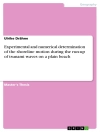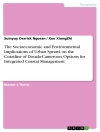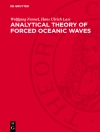This book presents a comprehensive analysis of diverse aspects of geohazards. The growing vulnerability and exposure to failures in risk reduction and policy-making increases the severity of geohazard impacts by many folds. Therefore, detailed geohazard analysis, modelling and forecasting are needed to reduce the impacts of extreme events.
An interdisciplinary approach to hazard mitigation provides an advanced tool for risk reduction. The book thus summarizes recent modelling and analysis techniques for hazard assessment and risk mitigation. Topics discussed in the book are hazard and risk associated with earthquakes, vulnerability assessment for landslides and avalanches, the assessment of tsunami risk in coastal regions, the implementation of early warning systems to prevent catastrophic consequences, climate change risk modelling and risk communication.
The convergent approach with the aspects of natural, engineering, and social sciences attracts a vast audienceworking to advance disaster science. This book also significantly facilitates the acquisition of policy-relevant knowledge for risk reduction, which is beneficial to the general public.
Содержание
Role of active tectonics in the estimation of seismic hazard of an area: A case study of western India.- Stress Scenario In The North-West Himalaya: What We Learnt From Post-Seismic Stress Changes.- The crust and upper mantle structure beneath the Bangladesh and its effects on seismic hazard.- Seismological data quality controls – a synthesis.- Use of Geophysical techniques in Seismic Hazard Assessment and Microzonation.- Earthquake response and its implications towards the structural design codes for Himalayan and adjoining regions of India.- Liquefaction Potential Index (LPI): A Parameter to Assess Liquefaction Hazard.- Earthquake Precursory Studies Using Radon Time Series Data in Taiwan: An Overview.- Spatial prediction of earthquake-induced landslide susceptible zones — A case study from Indian Himalaya.- Tsunamis in the past and recent years over Indian coasts: A review.- Instrumentation of India’s First Regional Earthquake Early Warning System and Site Characterization of its Stations.- Overview of Artificial Intelligence (AI) and Machine Learning (ML) in Seismology.
Об авторе
Sandeep has been working as an assistant professor in the Department of Geophysics, Banaras Hindu University (BHU) since 2016. His research interests include simulating strong ground motions, Site estimations and Earthquake Early Warnings. He is a lead or co-author of 32 journal articles in international peer-reviewed journals. Sandeep has also contributed to the scientific community as a reviewer of many research articles and projects. Sandeep is a recipient of many prestigious awards including Order of Merit Award (Young Scientists) by Indian Society of Earthquake Science (ISES), J.G. Negi Young Scientist award by Indian Geophysical Union and SERB-SIRE fellowship by DST, Go I for his significant contributions in the field of seismology.
Parveen Kumar currently works as a scientist at the Wadia Institute of Himalayan Geology, Dehradun, India. Earlier, he was awarded a post-doctoral fellow position sponsored by the University Grants Commission, India. He collaborated internationally in research with the Leibniz Institute for Applied Geophysics, Hanover, Germany. During his career, he has worked and is still working, on several sponsored and consultancy projects. His research interests include strong motion seismology, earthquake hazard evaluation, geohazard assessment such as landslide and avalanche hazards, and earthquake source studies. He has published over 37 research papers in SCI-indexed journals and supervised several Ph.D. and Master’s degree students.
Himanshu Mittal currently works as a scientist-E at the National Centre for Seismology, under the Ministry of Earth Sciences, New Delhi, India. His major expertise is in strong-motion seismology, earthquake hazard assessment, site characterization and Earthquake Early Warning (EEW), among other areas. Earlier, he has worked at many positions including Research Associate and Scientist at IIT Roorkee, Research Scientist (Post-doc) at National Taiwan University (NTU) and National Cheng Kung University (NCKU), Taiwan. Recently, he has developed EEW systems for different regions worldwide. He has published more than 40 research papers in SCI-indexed international journals and is actively engaged in collaboration with various national and international institutes.
Roshan Kumar currently works as an assistant professor at the Department of Electronic and Information Technology, Miami College of Henan University, China. Earlier, he completed his post-doc position at Zhejiang University, China. His research interests include earthquake early warning systems, seismic signal processing and landslide warning systems. He holds a Ph.D. from the Indian Institute of Technology, Roorkee, India, and a Master’s from Thapar University, India. To date, he has published more than 15 papers in his short academic career.












